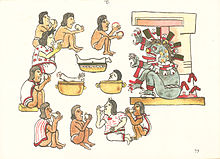
Back كودكس أزتيكي Arabic Còdexs mexiques Catalan Aztekencodices German Códices mexicas Spanish Kodex mexikak Basque دفترنامههای آزتک Persian Asteekkien koodeksit Finnish Codex aztèque French קודקס אצטקי HE Kodeks-kodeks Aztek ID








Aztec codices (Nahuatl languages: Mēxihcatl āmoxtli Nahuatl pronunciation: [meːˈʃiʔkatɬ aːˈmoʃtɬi], sing. codex) are Mesoamerican manuscripts made by the pre-Columbian Aztec, and their Nahuatl-speaking descendants during the colonial period in Mexico.[1]
- ^ Batalla, Juan José (2016-12-05). "The Historical Sources: Codices and Chronicles". In Nichols, Deborah L.; Rodríguez-Alegría, Enrique (eds.). The Oxford Handbook of the Aztecs. Vol. 1. Oxford University Press. pp. 29–40. doi:10.1093/oxfordhb/9780199341962.013.30.